Compact Switched-Inductor Power Supplies: Design Optimization with Second-Order Core Loss Model
Abstract
1. Compact Switched-Inductor Power Supplies
2. Design Model for Volume-Constrained Inductor
2.1. Ohmic-Loss Model
2.2. Core Loss Model
2.3. Design Tradeoffs for Saturable Inductors
3. Switched-Inductor Losses
3.1. Switched Inductor
3.2. Discontinuous Conduction
3.3. Continuous Conduction
3.4. Switched Inductor Variants
4. Switched-Inductor Design
4.1. Power Level
4.2. Discontinuous Conduction Optimization
4.3. Continuous Conduction Optimization
4.4. Design Error
5. Validation
5.1. Buck Prototype
5.2. Discontinuous-Conduction Error
5.3. Continuous-Conduction Error
5.4. Optimization Check
6. Conclusions
Author Contributions
Funding
Data Availability Statement
Acknowledgments
Conflicts of Interest
References
- Roy, A.; Klinefelter, A.; Yahya, F.B.; Chen, X.; Gonzalez-Guerrero, L.P.; Lukas, C.J.; Kamakshi, D.A.; Boley, J.; Craig, K.; Faisal, M.; et al. A 6.45 µW Self-Powered SoC with Integrated Energy-Harvesting Power Management and ULP Asymmetric Radios for Portable Biomedical Systems. IEEE Trans. Biomed. Circuits Syst. 2015, 9, 862–874. [Google Scholar] [CrossRef]
- Blaauw, D.; Sylvester, D.; Dutta, P.; Lee, Y.; Lee, I.; Bang, S.; Kim, Y.; Kim, G.; Pannuto, P.; Kuo, Y.-S.; et al. IoT design space challenges: Circuits and systems. In Proceedings of the 2014 Symposium on VLSI Technology, Honolulu, HI, USA, 9–12 June 2014; pp. 1–2. [Google Scholar] [CrossRef]
- Chen, W.-C.; Chen, C.-C.; Yao, C.-Y.; Yang, R.-J. A Fast-Transient Wide-Voltage-Range Digital-Controlled Buck Converter with Cycle-Controlled DPWM. IEEE Trans. Very Large Scale Integr. Syst. 2016, 24, 17–25. [Google Scholar] [CrossRef]
- Li, Y.; Zhu, Z. A Capacitor-Free Control Scheme for a Primary-Side Controlled Flyback Converter. IEEE Trans. Power Electron. 2020, 35, 9482–9493. [Google Scholar] [CrossRef]
- Hong, X.-E.; Wu, J.-F.; Wei, C.-L. 98.1%-Efficiency Hysteretic-Current-Mode Noninverting Buck–Boost DC-DC Converter with Smooth Mode Transition. IEEE Trans. Power Electron. 2017, 32, 2008–2017. [Google Scholar] [CrossRef]
- Kim, J.-H.; Kim, J.-K.; Lee, J.-B.; Moon, G.-W. Load Adaptive Gate Driving Method for High Efficiency Under Light-Load Conditions. IEEE Trans. Ind. Electron. 2014, 61, 4674–4679. [Google Scholar] [CrossRef]
- Abramov, E.; Vekslender, T.; Kirshenboim, O.; Peretz, M.M. Fully Integrated Digital Average Current-Mode Control Voltage Regulator Module IC. IEEE J. Emerg. Sel. Top. Power Electron. 2018, 6, 485–499. [Google Scholar] [CrossRef]
- Yuan, B.; Liu, M.-X.; Ng, W.T.; Lai, X.-Q. Hybrid Buck Converter with Constant Mode Changing Point and Smooth Mode Transition for High-Frequency Applications. IEEE Trans. Ind. Electron. 2020, 67, 1466–1474. [Google Scholar] [CrossRef]
- Suh, J.-D.; Seok, J.; Kong, B.-S. A Fast Response PWM Buck Converter with Active Ramp Tracking Control in a Load Transient Period. IEEE Trans. Circuits Syst. II Express Briefs 2019, 66, 467–471. [Google Scholar] [CrossRef]
- Kapat, S.; Mandi, B.C.; Patra, A. Voltage-Mode Digital Pulse Skipping Control of a DC–DC Converter with Stable Periodic Behavior and Improved Light-Load Efficiency. IEEE Trans. Power Electron. 2016, 31, 3372–3379. [Google Scholar] [CrossRef]
- Hong, W.; Lee, M. A 7.4-MHz Tri-Mode DC-DC Buck Converter with Load Current Prediction Scheme and Seamless Mode Transition for IoT Applications. IEEE Trans. Circuits Syst. I Regul. Pap. 2020, 67, 4544–4555. [Google Scholar] [CrossRef]
- Huang, C.-H.; Chen, C.-C. A High-Efficiency Current-Mode Buck Converter with a Power-Loss-Aware Switch-On-Demand Modulation Technique for Multifunction SoCs. IEEE Trans. Power Electron. 2016, 31, 8303–8316. [Google Scholar] [CrossRef]
- Zhou, X.; Wang, T.G.; Lee, F.C. Optimizing design for low voltage DC-DC converters. In Proceedings of the Applied Power Electronics Conference (APEC), Atlanta, GA, USA, 23 February 1997; Volume 2, pp. 612–616. [Google Scholar] [CrossRef]
- Venkatachalam, K.; Sullivan, C.R.; Abdallah, T.; Tacca, H. Accurate prediction of ferrite core loss with nonsinusoidal waveforms using only Steinmetz parameters. In Proceedings of the 2002 IEEE Workshop on Computers in Power Electronics, Tel Aviv, Israel, 3–4 June 2002; pp. 36–41. [Google Scholar] [CrossRef]
- Górecki, K.; Detka, K. Analysis of influence of losses in the core of the inductor on parameters of the buck converter. In Proceedings of the 2018 Baltic URSI Symposium (URSI), Poznan, Poland, 14–17 May 2018; pp. 129–132. [Google Scholar] [CrossRef]
- Matsumori, H.; Shimizu, T.; Wang, X.; Blaabjerg, F. A Practical Core Loss Model for Filter Inductors of Power Electronic Converters. IEEE J. Emerg. Sel. Top. Power Electron. 2018, 6, 29–39. [Google Scholar] [CrossRef]
- Roshen, W.A. A Practical, Accurate and Very General Core Loss Model for Nonsinusoidal Waveforms. IEEE Trans. Power Electron. 2007, 22, 30–40. [Google Scholar] [CrossRef]
- Schrom, G.; Hazucha, P.; Paillet, F.; Gardner, D.S.; Moon, S.T.; Karnik, T. Optimal Design of Monolithic Integrated DC-DC Converters. In Proceedings of the 2006 IEEE International Conference on IC Design and Technology, Padua, Italy, 1–4 May 2006; pp. 1–3. [Google Scholar] [CrossRef]
- Yang, S.; Rincon-Mora, G.A. Piezoelectric CMOS charger: Highest output power Design. In Proceedings of the 2020 IEEE nternational Symposium on Quality Electronic Design, Santa Clara, CA, USA, 25–26 March 2020. [Google Scholar] [CrossRef]
- Sizikov, G.; Kolodny, A.; Fridman, E.G.; Zelikson, M. Efficiency optimization of integrated DC-DC buck converters. In Proceedings of the 2010 17th IEEE International Conference on Electronics, Circuits and Systems, Athens, Greece, 12–15 December 2010; pp. 1208–1211. [Google Scholar] [CrossRef]
- Villar, G.; Alarcon, E.; Guinjoan, F.; Poveda, A. Efficiency-oriented switching frequency tuning for a buck switching power converter. In Proceedings of the 2005 IEEE International Symposium on Circuits and Systems, Kobe, Japan, 23–26 May 2005; Volume 3, pp. 2473–2476. [Google Scholar] [CrossRef]
- Katayama, Y.; Edo, M.; Denta, T.; Kawashima, T.; Ninomiya, T. Optimum design method of CMOS IC for DC-DC converter that integrates power stage MOSFETs. In Proceedings of the 2004 IEEE 35th Annual Power Electronics Specialists Conference, Aachen, Germany, 20 June 2004; pp. 4486–4491. [Google Scholar] [CrossRef]
- Kursun, V.; Narendra, S.G.; De, V.K.; Friedman, E.G. Low-voltage-swing monolithic dc-dc conversion. IEEE Trans. Circuits Syst. II Express Briefs 2004, 51, 241–248. [Google Scholar] [CrossRef]
- Kursun, V.; Narendra, S.G.; De, V.K.; Friedman, E.G. Efficiency analysis of a high frequency buck converter for on-chip integration with a dual-VDD microprocessor. In Proceedings of the 28th European Solid-State Circuits Conference, Florence, Italy, 24–26 September 2002; pp. 743–746. [Google Scholar]
- Haizoune, F.; Bergveld, H.J.; Popovic-Gerber, J.; Ferreira, J.A. Topology comparison and design optimisation of the buck converter and the single-inductor dual-output converter for system-in-package in 65nm CMOS. In Proceedings of the 2009 IEEE 6th International Power Electronics and Motion Control Conference, Wuhan, China, 17–20 May 2009; pp. 295–301. [Google Scholar] [CrossRef]
- Wang, Y.; Zhang, D.; Lu, L.; Huang, B.; Xu, H.; Min, R.; Zou, X. Technical Reviews of Power Loss Optimization in High-Frequency PSiPs—In Relation to Power Switches and Power Inductors. Appl. Sci. 2023, 13, 13166. [Google Scholar] [CrossRef]
- Beohar, N.; Mandal, D.; Parasuram, V.; Reddy, A.M.; Kumar, A.; Malladi, V.N.K.; Pappu, K.; Fu, C.; Adell, P.C.; Bakkaloglu, B. A Digitally Controlled DC-DC Buck Converter with Automatic Digital PFM to PWM Transition Scheme. In Proceedings of the 2021 IEEE Applied Power Electronics Conference and Exposition (APEC), Phoenix, AZ, USA, 14–17 June 2021; pp. 517–522. [Google Scholar] [CrossRef]
- Huang, W.; Liu, L.; Liao, X.; Xu, C.; Li, Y. A 240-nA Quiescent Current, 95.8% Efficiency AOT-Controlled Buck Converter with A2-Comparator and Sleep-Time Detector for IoT Application. IEEE Trans. Power Electron. 2021, 36, 12898–12909. [Google Scholar] [CrossRef]
- Hong, W.; Lee, M. A 10-MHz Current-Mode AOT Boost Converter with Dual-Ramp Modulation Scheme and Translinear Loop-Based Current Sensor for WiFi IoT Applications. IEEE J. Solid-State Circuits 2021, 56, 2388–2401. [Google Scholar] [CrossRef]
- Chang, T.; Rincón-Mora, G.A. Optimal High-Efficiency DCM Design of Switched-Inductor CMOS Power Supplies. In Proceedings of the 2021 IEEE International Midwest Symposium on Circuits and Systems (MWSCAS), Lansing, MI, USA, 9–11 August 2021; pp. 475–478. [Google Scholar] [CrossRef]
- Kim, S.; Rincon-Mora, G.A. Achieving high efficiency under micro-watt loads with switching buck dc-dc converters. J. Low Power Electron. 2009, 5, 229–240. [Google Scholar] [CrossRef]
- Prabha, R.D.; Rincon-Mora, G.A. Maximizing power-transfer efficiency in low-power DC-DC converters. IET Electron. Lett. 2015, 51, 1918–1920. [Google Scholar] [CrossRef]
- Yamauchi, Y.; Yanagihara, Y.; Fuketa, H.; Sakurai, T.; Takamiya, M. Optimal design to maximize efficiency of single-inductor multiple-output buck converters in discontinuous conduction mode for IoT applications. In Proceedings of the 2015 International Conference on IC Design & Technology (ICICDT), Leuven, Belgium, 1–3 June 2015; pp. 1–4. [Google Scholar] [CrossRef]
- Carroll, A.; Heiser, G. An analysis of power consumption in a smartphone. In Proceedings of the 2010 USENIX Conference on USENIX Annual Technical Conference (USENIXATC’10), Boston, MA, USA, 22–25 June 2010; p. 21. [Google Scholar]
- Rincón-Mora, G.A. Switched Inductor Power IC Design, 1st ed.; Springer: New York, NY, USA, 2022. [Google Scholar]
- Michal, V. Peak-Efficiency Detection and Peak-Efficiency Tracking Algorithm for Switched-Mode DC–DC Power Converters. IEEE Trans. Power Electron. 2014, 29, 6555–6568. [Google Scholar] [CrossRef]
- Renz, P.; Kaufmann, M.; Lueders, M.; Wicht, B. Switch Stacking in Power Management ICs. IEEE J. Emerg. Sel. Top. Power Electron. 2021, 9, 3735–3743. [Google Scholar] [CrossRef]
- Malcovati, P.; Belloni, M.; Gozzini, F.; Bazzani, C.; Baschirotto, A. A 0.18-µm CMOS, 91%-Efficiency, 2-A Scalable Buck-Boost DC–DC Converter for LED Drivers. IEEE Trans. Power Electron. 2014, 29, 5392–5398. [Google Scholar] [CrossRef]
- Park, S.-Y.; Cho, J.; Lee, K.; Yoon, E. A PWM Buck Converter with Load-Adaptive Power Transistor Scaling Scheme Using Analog-Digital Hybrid Control for High Energy Efficiency in Implantable Biomedical Systems. IEEE Trans. Biomed. Circuits Syst. 2015, 9, 885–895. [Google Scholar] [CrossRef] [PubMed]
- Huang, C.; Mok, P.K.T. An 84.7% Efficiency 100-MHz Package Bondwire-Based Fully Integrated Buck Converter with Precise DCM Operation and Enhanced Light-Load Efficiency. IEEE J. Solid-State Circuits 2013, 48, 2595–2607. [Google Scholar] [CrossRef]
- Sun, Y.; Adrian, V.; Chang, J.S. Power-Loss and Design Space Analyses for Fully-Integrated Switched-Mode DC-DC Converters. In Proceedings of the 2018 IEEE International Symposium on Circuits and Systems (ISCAS), Florence, Italy, 27–30 May 2018; pp. 1–4. [Google Scholar] [CrossRef]
- Kudva, S.S.; Harjani, R. Fully integrated on-chip DC-DC converter with a 450x output range. In Proceedings of the 2010 IEEE Custom Integrated Circuits Conference, San Jose, CA, USA, 19–22 September 2010; pp. 1–4. [Google Scholar] [CrossRef]
- Geng, Y.; Ma, D. A 100-MHz Breakdown-Resilient Power Converter with Fully Monolithic Implementation on Nanoscale CMOS Process. IEEE Trans. Ind. Electron. 2015, 62, 5529–5538. [Google Scholar] [CrossRef]
- Chan, R.; Guo, J. Analysis and modeling of skin and proximity effects for millimeter-wave inductors design in nanoscale Si CMOS. In Proceedings of the 2014 9th European Microwave Integrated Circuit Conference, Rome, Italy, 6–7 October 2014; pp. 13–16. [Google Scholar] [CrossRef]
- Leng, W.; Abidi, A.A. Approximate Equivalent Circuits to Understand Tradeoffs in Geometry of On-Chip Inductors. IEEE Trans. Circuits Syst. I Regul. Pap. 2021, 68, 975–988. [Google Scholar] [CrossRef]
- Gassab, O.; Xie, H.; Chen, Y.; Wen, D.-E.; Du, S.; Luo, K.; He, F.; Meng, J.; Zhao, D.; Xiao, D.; et al. Fast and Accurate Semi-Analytical Solution to Skin and Proximity Effects in Shielded Cable Systems. IEEE Trans. Electromagn. Compat. 2023, 65, 1632–1646. [Google Scholar] [CrossRef]
- El Hajji, T.; Hlioui, S.; Louf, F.; Gabsi, M.; Belahcen, A.; Mermaz-Rollet, G.; Belhadi, M. AC Losses in Windings: Review and Comparison of Models with Application in Electric Machines. IEEE Access 2024, 12, 1552–1569. [Google Scholar] [CrossRef]
- Rashid, M.H. Magnetic Circuit Design for Power Electronics. In Power Electronics Handbook, 4th ed.; Butterworth-Heinemann: Oxford, UK, 2017; p. 573. [Google Scholar]
- Coilcraft, Spice Models/S-Parameters. Available online: http://coilcraft.com/en-us/models/spice/?seriesName=XGL5050 (accessed on 24 July 2024).
- Texas Instruments, Section 2: Magnetic Core Charasteristics, Application Note. Available online: http://ti.com/lit/ml/slup124/slup124.pdf (accessed on 24 July 2024).
- Kaiser, J.; Dürbaum, T. An Overview of Saturable Inductors: Applications to Power Supplies. IEEE Trans. Power Electron. 2021, 36, 10766–10775. [Google Scholar] [CrossRef]
- Texas Instruments, Section 1: Introduction and Basic Magnetics, Application Note. Available online: http://ti.com/lit/ml/slup123/slup123.pdf (accessed on 24 July 2024).
- Rodriguez-Sotelo, D.; Rodriguez-Licea, M.A.; Soriano-Sanchez, A.G.; Espinosa-Calderon, A.; Perez-Pinal, F.J. Advanced Ferromagnetic Materials in Power Electronic Converters: A State of the Art. IEEE Access 2020, 8, 56238–56252. [Google Scholar] [CrossRef]
- Sudhoff, S.D. Magnetics and Magnetic Equivalent Circuits. In Power Magnetic Devices: A Multi-Objective Design Approach, 2nd ed.; John Wiley and Sons: Hoboken, NJ, USA, 2014; pp. 54–55. [Google Scholar]
- Sato, T.; Aya, S.; Igarashi, H.; Suzuki, M.; Iwasaki, Y.; Kawano, K. Loss Computation of Soft Magnetic Composite Inductors Based on Interpolated Scalar Magnetic Property. IEEE Trans. Magn. 2015, 51, 8001704. [Google Scholar] [CrossRef]
- Barg, S.; Bertilsson, K. Core Loss Modeling and Calculation for Trapezoidal Magnetic Flux Density Waveform. IEEE Trans. Ind. Electron. 2021, 68, 7975–7984. [Google Scholar] [CrossRef]
- Chen, W.; Huang, X.; Cao, S.; Ma, J.; Fang, Y. Predicting Iron Losses in Soft Magnetic Materials Under DC Bias Conditions Based on Steinmetz Premagnetization Graph. IEEE Trans. Magn. 2016, 52, 1–4. [Google Scholar] [CrossRef]
- Lee, E.S.; Guk, B. Choi Calculation Methodologies of Complex Permeability for Various Magnetic Materials. Electronics 2021, 10, 2167. [Google Scholar] [CrossRef]
- Tekgun, B.; Sozer, Y.; Tsukerman, I.; Upadhyay, P.; Englebretson, S. Core Loss Estimation in Electric Machines with Flux-Controlled Core Loss Tester. IEEE Trans. Ind. Appl. 2019, 55, 1299–1308. [Google Scholar] [CrossRef]
- Javidi, N.F.; Nymand, M. Error analysis of high frequency core loss measurement for low-permeability low-loss magnetic cores. In Proceedings of the 2016 IEEE 2nd Annual Southern Power Electronics Conference (SPEC), Auckland, New Zealand, 5–8 December 2016; pp. 1–6. [Google Scholar] [CrossRef]
- Seo, S.; Kim, H.D.; Lee, K.H.; Park, I.H. Numerical and Experimental Characterization of Thread-Type Magnetic Core with Low Eddy Current Loss. IEEE Trans. Magn. 2015, 51, 6301204. [Google Scholar] [CrossRef]
- Yu, W.; Hua, W.; Zhang, Z. High-Frequency Core Loss Analysis of High-Speed Flux-Switching Permanent Magnet Machines. Electronics 2021, 10, 1076. [Google Scholar] [CrossRef]
- Szczerba, P.; Ligenza, S.; Worek, C. Measurement and Calculation Techniques of Complex Permeability Applied to Mn-Zn Ferrites Based on Iterative Approximation Curve Fitting and Modified Equivalent Inductor Model. Electronics 2023, 12, 4002. [Google Scholar] [CrossRef]
- Muhlethaler, J.; Biela, J.; Kolar, J.W.; Ecklebe, A. Core Losses Under the DC Bias Condition Based on Steinmetz Parameters. IEEE Trans. Power Electron. 2012, 27, 953–963. [Google Scholar] [CrossRef]
- Milner, L.A.; Rincon-Mora, G.A. Small saturating inductors for more compact switching power supplies. IEEJ Trans. Electr. Electron. Eng. 2012, 7, 69–73. [Google Scholar] [CrossRef]
- Shimizu, T.; Mishima, K.; Wada, K.; Ishii, K. Mitigation of Inductor Loss Based on Minor-Loop Hysteresis Characteristics. In Proceedings of the 25th International Telecommunications Energy Conference, Yokohama, Japan, 23 October 2003; pp. 834–839. [Google Scholar]
- Wilson, P.R.; Ross, J.N.; Brown, A.D. Simulation of Magnetic Component Models in Electric Circuits Including Dynamic Thermal Effects. IEEE Trans. Power Electron. 2002, 17, 55–65. [Google Scholar] [CrossRef]
- Scirè, D.; Lullo, G.; Vitale, G. Non-Linear Inductor Models Comparison for Switched-Mode Power Supplies Applications. Electronics 2022, 11, 2472. [Google Scholar] [CrossRef]
- Ravera, P.A.; Oliveri, A.; Lodi, M.; Storace, M. Use of a Partially Saturating Inductor in a Boost Converter with Model Predictive Control. Electronics 2023, 12, 3013. [Google Scholar] [CrossRef]
- Erickson, R.W.; Maksimović, D. Filter Inductor Design Constraints. In Fundamentals of Power Electronics, 2nd ed.; Springer: New York, NY, USA; pp. 459–463.


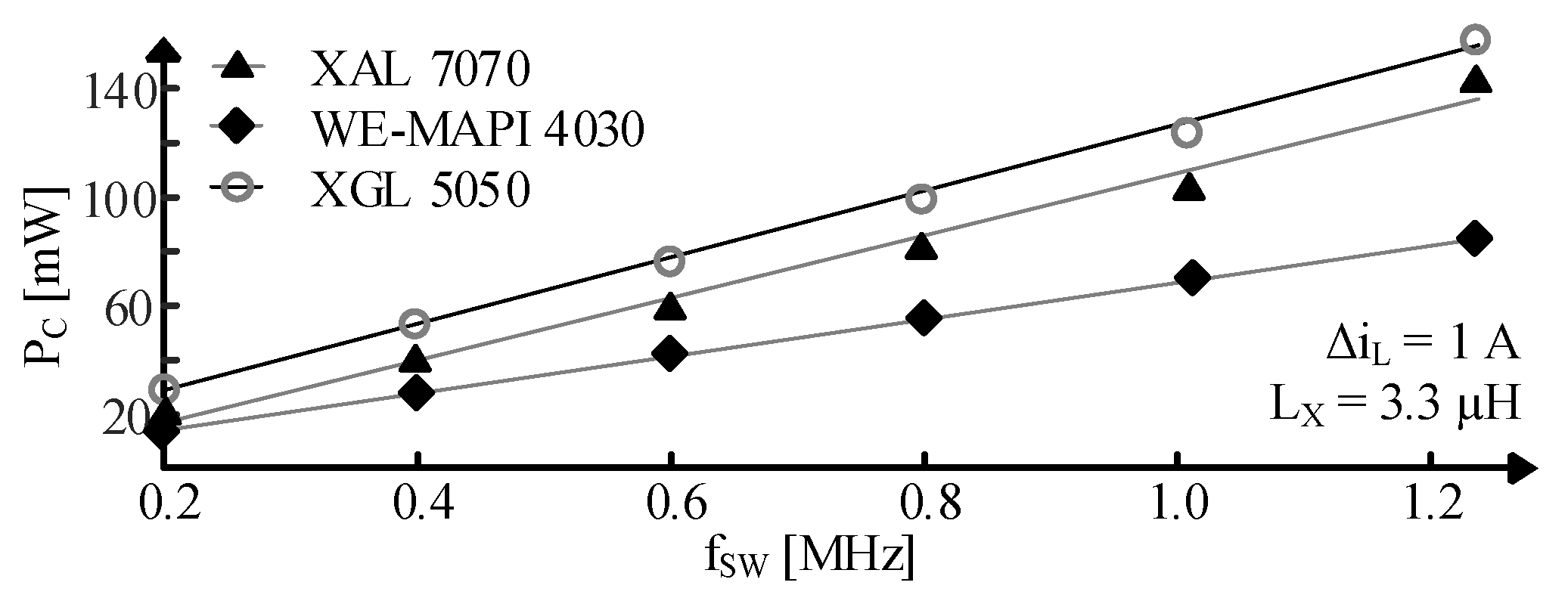
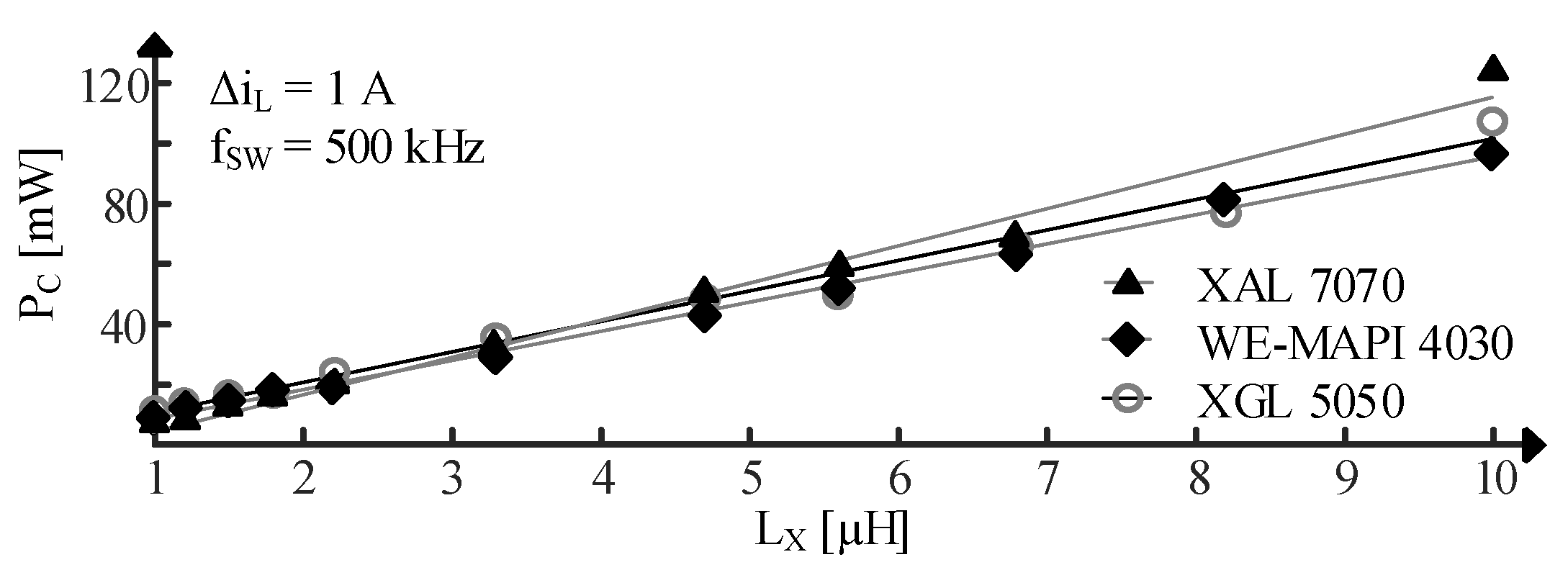


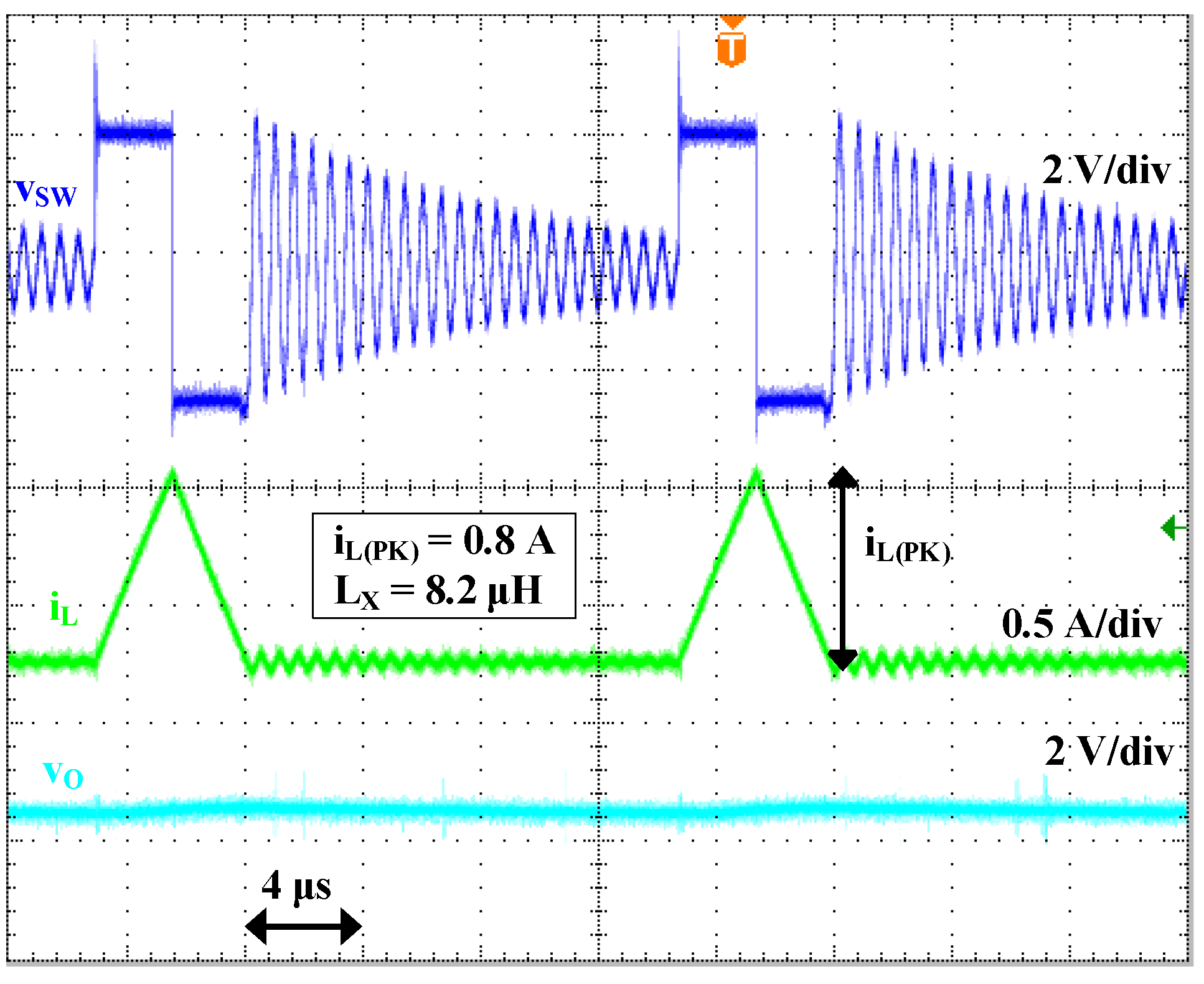



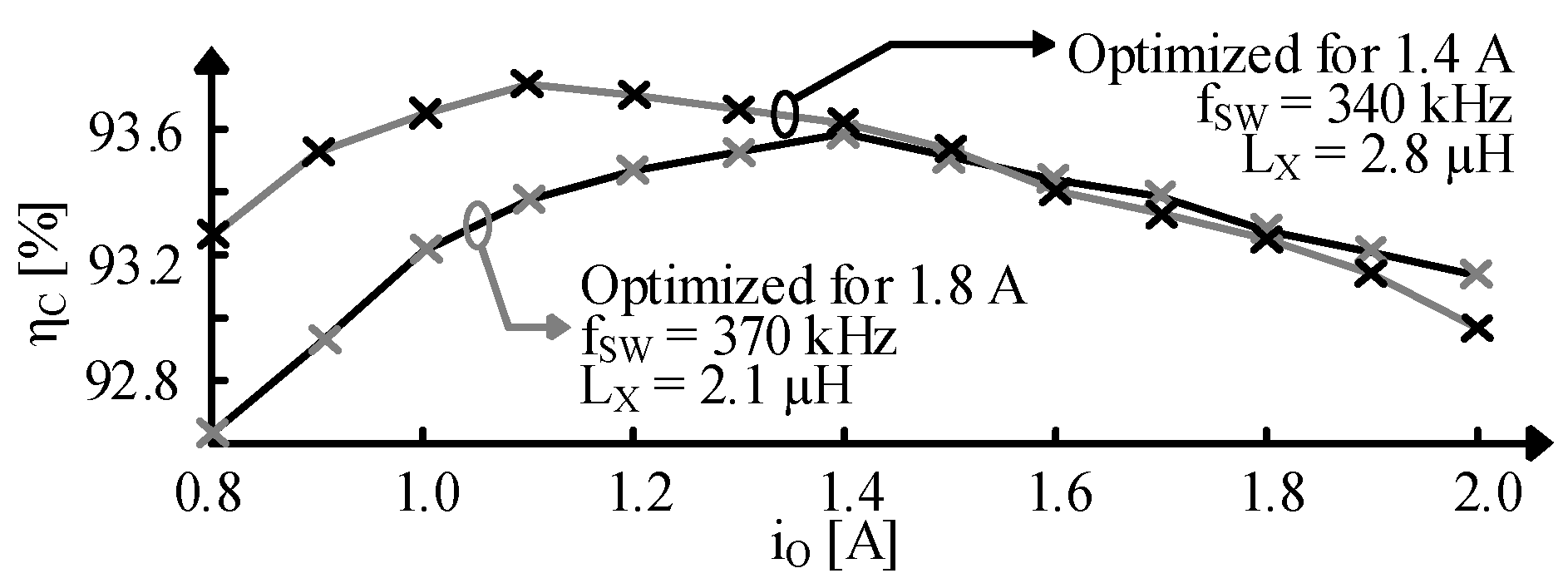
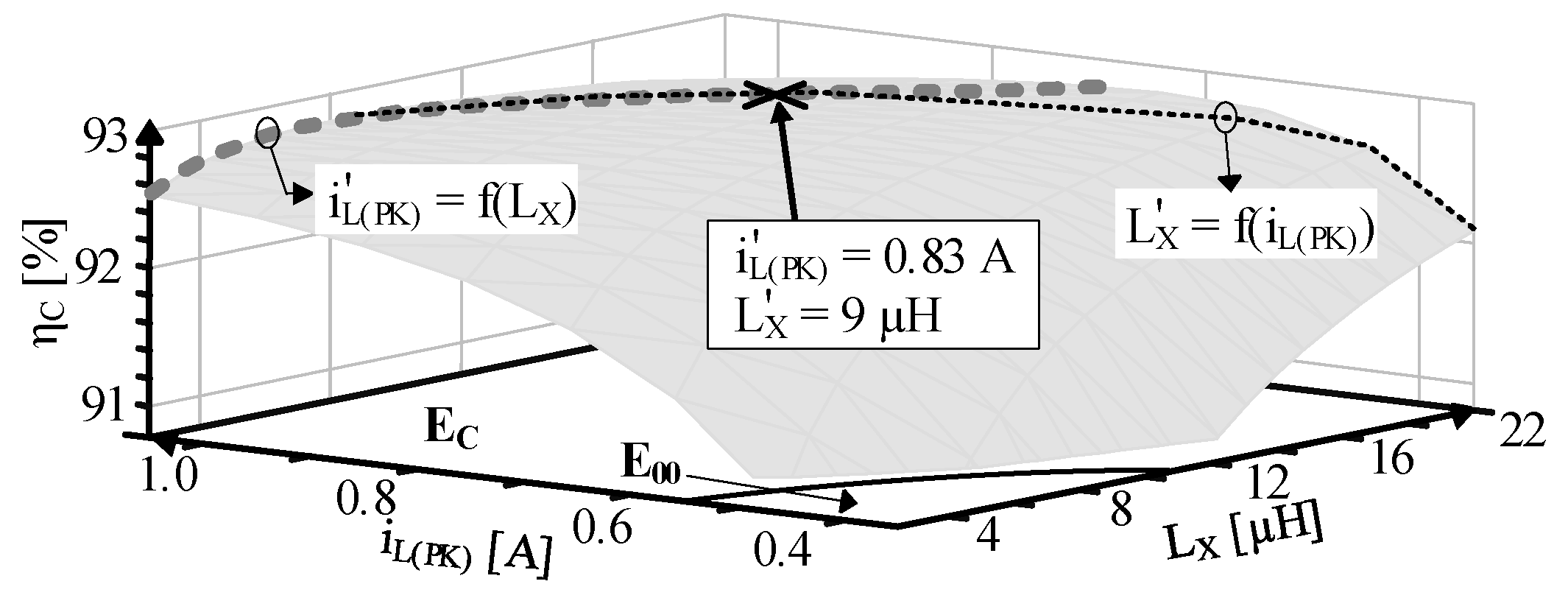
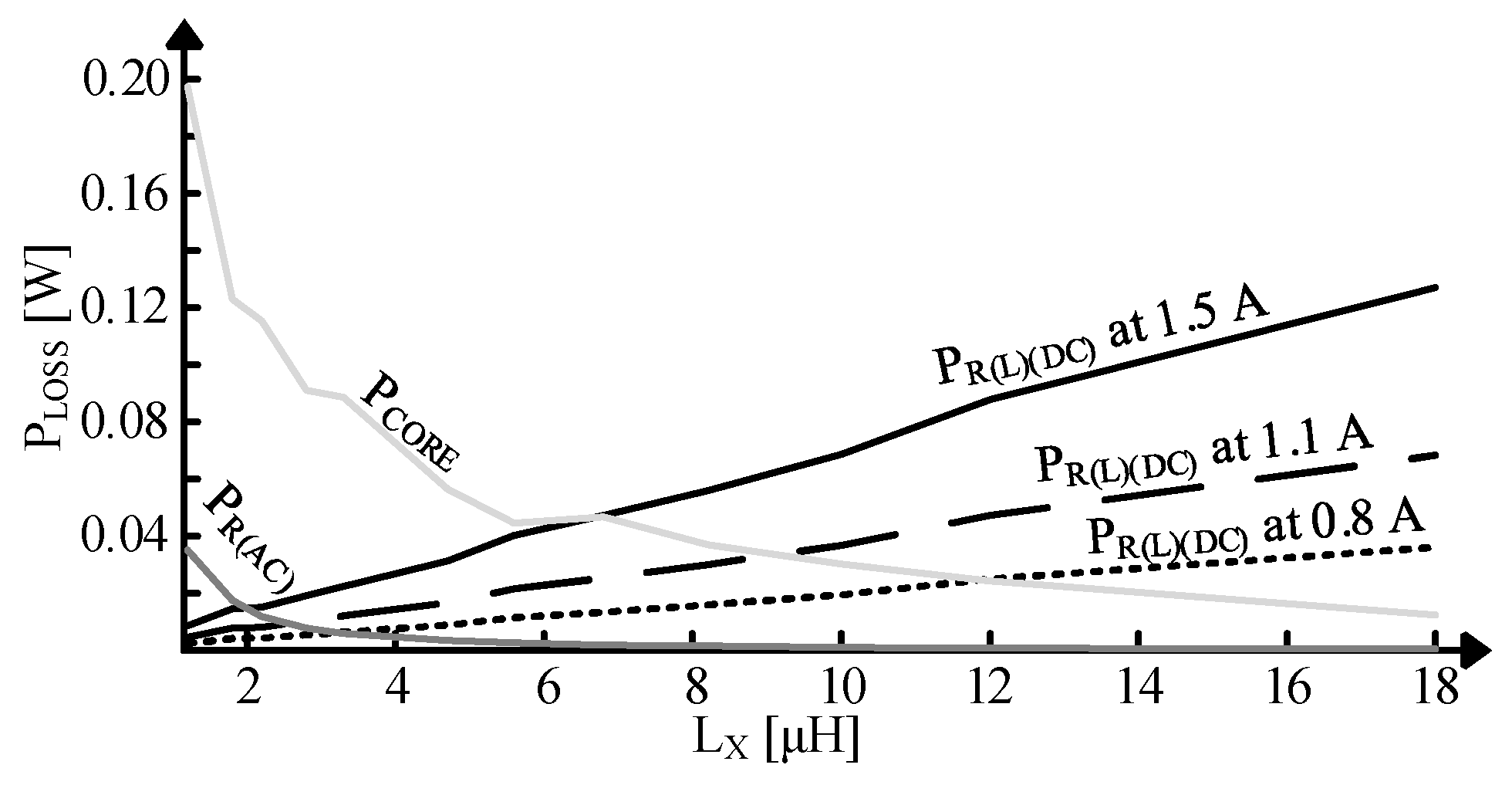


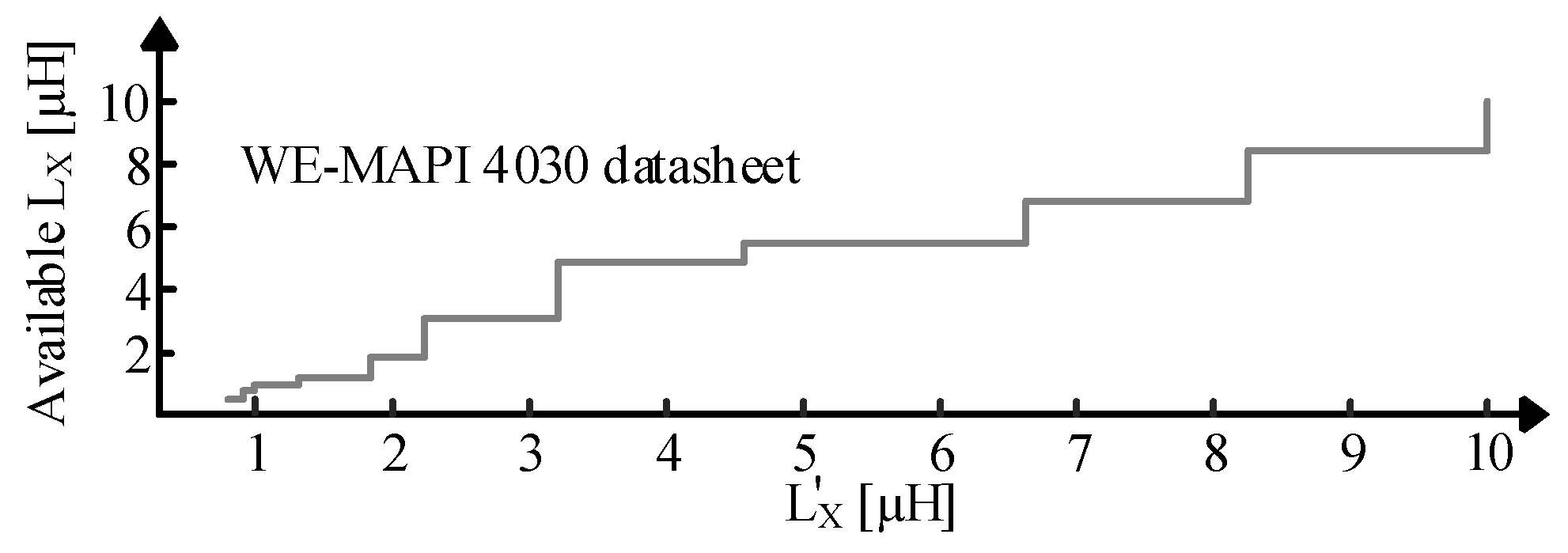

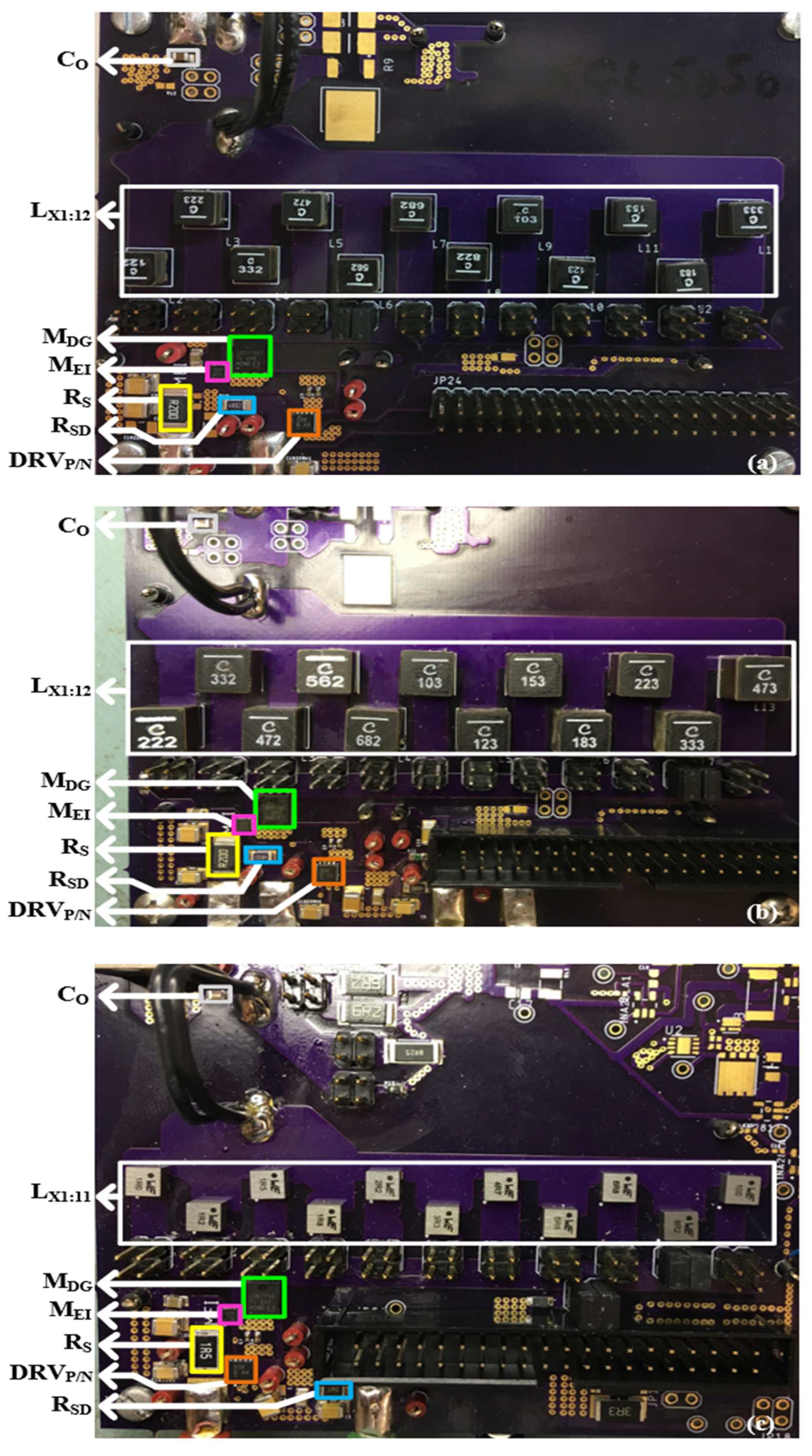

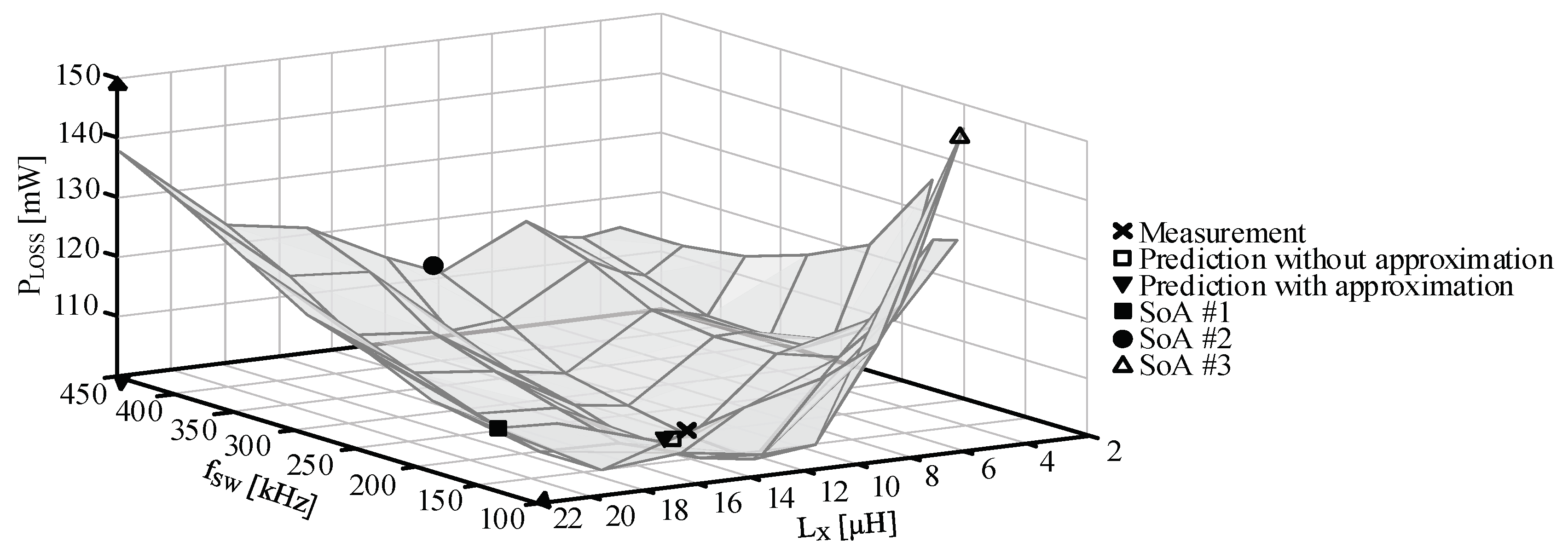



| # | Serie | kRL [mΩ/µH] | kC [W/Hz/H/A2] |
|---|---|---|---|
 | XGL 5050 | 3.2 | 0.032 |
 | WE-MAPI 4030 | 10.3 | 0.023 |
 | 1812CS (Air core) | 756 | N/A |
 | XAL 7070 | 1.9 | 0.032 |
| Topology | ||
|---|---|---|
| Non-inverting Buck–Boost | ||
| Buck | ||
| Boost | ||
| Inverting Buck–Boost |
| Optimization Scheme | EP | ||
|---|---|---|---|
| Minimum measured | 0.8 A, 8.2 µH | 21.3 mW | - |
| SoA #1 (missing IV, DT loss) | 0.94 A, 4 µH | 24.8 mW | 16.4% |
| SoA #2 (missing core loss) | 0.84 A, 7.6 µH | 22.1 mW | 0% |
| Prediction from this work without approximation | 0.84 A, 7.6 µH | 21.3 mW | 0% |
| Prediction from this work with approximation | 0.76 A, 7.7 µH | 21.3 mW | 0% |
| Optimization Scheme | EP | ||
|---|---|---|---|
| Minimum measured | 400 mA, 47 µH | 31.7 mW | - |
| SoA #1 (missing IV, DT loss) | 530 mA, 23 µH | 33.2 mW | 4.7% |
| SoA #2 (missing core loss) | 480 mA, 37 µH | 32.7 mW | 3.2% |
| Prediction from this work without approximation | 480 mA, 37 µH | 32.7 mW | 3.2% |
| Prediction from this work with approximation | 440 mA, 39 µH | 32.4 mW | 2.2% |
| Optimization Scheme | EP | ||
|---|---|---|---|
| Minimum measured | 500 mA, 22 µH | 22.8 mW | - |
| SoA #1 (missing IV, DT loss) | 610 mA, 14.7 µH | 23.5 mW | 3.1% |
| SoA #2 (missing core loss) | 540 mA, 23.5 µH | 22.8 mW | 0% |
| Prediction from this work without approximation | 540 mA, 23.5 µH | 22.8 mW | 0% |
| Prediction from this work with approximation | 500 mA, 24.3 µH | 22.8 mW | 0% |
| Optimization Scheme | EP | ||
|---|---|---|---|
| Minimum measured | 200 kHz, 10 μH | 103 mW | - |
| is optimized) | 150 kHz, 22 μH | 116 mW | 12.6% |
| SoA #2 (missing IV, DT loss) | 420 kHz, 8.9 μH | 112 mW | 8.7% |
| SoA #3 (missing core loss) | 120 kHz, 7.6 μH | 146 mW | 41.7% |
| Prediction from this work without approximation | 190 kHz, 11.2 μH | 104 mW | 0.9% |
| Prediction from this work with approximation | 180 kHz, 11.6 μH | 104 mW | 0.9% |
| Optimization Scheme | EP | ||
|---|---|---|---|
| Minimum measured | 350 kHz, 3.3 µH | 184 mW | - |
| is optimized) | 550 kHz, 1.2 µH | 261 mW | 41.8% |
| SoA #2 (missing IV, DT loss) | 630 kHz, 2.4 µH | 296 mW | 60.8% |
| SoA #3 (missing core loss) | 370 kHz, 2.5 µH | 236 mW | 28.2% |
| Prediction from this work without approximation | 330 kHz, 3.9 µH | 184 mW | 0% |
| Prediction from this work with approximation | 320 kHz, 3.8 µH | 186 mW | 1% |
| Optimization Scheme | EP | ||
|---|---|---|---|
| Minimum measured | 250 kHz, 8.2 µH | 185 mW | - |
| is optimized) | 500 kHz, 1.2 µH | 342 mW | 84.9% |
| SoA #2 (missing IV, DT loss) | 550 kHz, 5.1 µH | 223 mW | 20.5% |
| SoA #3 (missing core loss) | 180 kHz, 5 µH | 215 mW | 16.2% |
| Prediction from this work without approximation | 250 kHz, 8 µH | 185 mW | 0% |
| Prediction from this work with approximation | 240 kHz, 7.6 µH | 185 mW | 0% |
| Optimization Scheme | EP | ||
|---|---|---|---|
| Minimum measured | 250 kHz, 5.8 µH | 291 mW | - |
| is optimized) | 550 kHz, 1.2 µH | 512 mW | 76% |
| SoA #2 (missing IV, DT loss) | 680 kHz, 3.4 µH | 426 mW | 46.4% |
| SoA #3 (missing core loss) | 200 kHz, 3.8 µH | 351 mW | 20.6% |
| Prediction from this work without approximation | 260 kHz, 5.9 µH | 291 mW | 0% |
| Prediction from this work with approximation | 250 kHz, 5.5 µH | 291 mW | 0% |
| Optimization Scheme | EP | ||
|---|---|---|---|
| Minimum measured | 450 kHz, 2.2 µH | 289 mW | - |
| is optimized) | 200 kHz, 10 µH | 406 mW | 40.5% |
| SoA #2 (missing IV, DT loss) | 720 kHz, 1.4 µH | 434 mW | 50.2% |
| SoA #3 (missing core loss) | 405 kHz, 1.7 µH | 324 mW | 8.7% |
| Prediction from this work without approximation | 410 kHz, 2.5 µH | 300 mW | 0.6% |
| Prediction from this work with approximation | 370 kHz, 2.5 µH | 300 mW | 0.6% |
| Optimization Scheme | EP | ||
|---|---|---|---|
| Minimum measured | 250 kHz, 10 µH | 168 mW | - |
| is optimized) | 500 kHz, 2.2 µH | 203 mW | 20.8% |
| SoA #2 (missing IV, DT loss) | 510 kHz, 4.9 µH | 187 mW | 11.3% |
| SoA #3 (missing core loss) | 130 kHz, 5.6 µH | 187 mW | 11.3% |
| Prediction from this work without approximation | 230 kHz, 8.5µH | 168 mW | 0% |
| Prediction from this work with approximation | 210 kHz, 8.6 µH | 168 mW | 0% |
Disclaimer/Publisher’s Note: The statements, opinions and data contained in all publications are solely those of the individual author(s) and contributor(s) and not of MDPI and/or the editor(s). MDPI and/or the editor(s) disclaim responsibility for any injury to people or property resulting from any ideas, methods, instructions or products referred to in the content. |
© 2024 by the authors. Licensee MDPI, Basel, Switzerland. This article is an open access article distributed under the terms and conditions of the Creative Commons Attribution (CC BY) license (https://creativecommons.org/licenses/by/4.0/).
Share and Cite
Guérin, G.; Rincón-Mora, G.A. Compact Switched-Inductor Power Supplies: Design Optimization with Second-Order Core Loss Model. Electronics 2024, 13, 2977. https://doi.org/10.3390/electronics13152977
Guérin G, Rincón-Mora GA. Compact Switched-Inductor Power Supplies: Design Optimization with Second-Order Core Loss Model. Electronics. 2024; 13(15):2977. https://doi.org/10.3390/electronics13152977
Chicago/Turabian StyleGuérin, Guillaume, and Gabriel A. Rincón-Mora. 2024. "Compact Switched-Inductor Power Supplies: Design Optimization with Second-Order Core Loss Model" Electronics 13, no. 15: 2977. https://doi.org/10.3390/electronics13152977
APA StyleGuérin, G., & Rincón-Mora, G. A. (2024). Compact Switched-Inductor Power Supplies: Design Optimization with Second-Order Core Loss Model. Electronics, 13(15), 2977. https://doi.org/10.3390/electronics13152977






